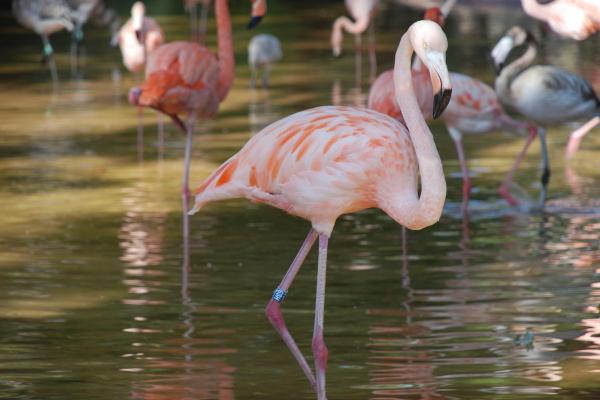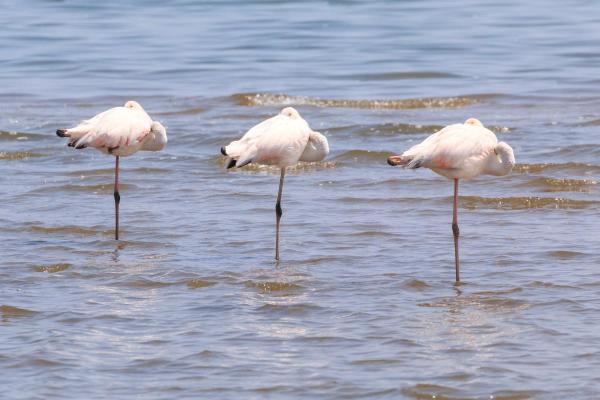Why Do Flamingos Stand on One Foot?


Flamingos, with their vibrant plumage and graceful elegance, are a familiar sight in many corners of the world. But beyond their captivating appearance lies a curious habit: standing on one leg. While it might seem like a quirky pose, this behavior has piqued the interest of scientists and birdwatchers for years. So, why do these pink-feathered wonders choose to stand on one foot?
The answer, as with many things in nature, is multifaceted. In the following AnimalWised article, we will explore all the reasons why flamingos stand in one leg.
Thermoregulation
Flamingos are known for their ability to thrive in a wide range of environments, from warm tropical waters to cooler temperate regions. Their unique behavior of standing on one leg may indeed be linked to their need to regulate body temperature effectively, a crucial aspect of their adaptation to diverse habitats.
Flamingos are often found in areas where water temperatures can fluctuate. By tucking one leg close to their bodies, they reduce the exposed surface area, minimizing heat loss.
The blood vessels in the legs of flamingos play a significant role in temperature regulation. When standing on one leg, flamingos can constrict the blood vessels in the tucked leg, reducing blood flow to the extremity. This vasoconstriction helps in retaining body heat by preventing warmth from escaping through the legs.
The extended leg, on the other hand, remains exposed to the surrounding air or water. This provides an opportunity for thermal exchange, allowing excess heat from the flamingo's body to dissipate through the surface of the extended leg. This thermal regulation is particularly important in warmer environments, where the dissipation of heat becomes crucial for preventing overheating.

Energy conservation
The behavior of flamingos standing on one leg is also thought to have a practical purpose related to energy conservation, particularly in environments with colder temperatures.
This seemingly straightforward act serves as a means for the birds to regulate their body temperature more effectively. By minimizing the surface area exposed to the cooler air, flamingos reduce the potential for heat loss. It's comparable to wearing an extra layer of insulation in chilly weather. This adaptation helps them stay warm without expending unnecessary energy.
The one-legged stance is a multifaceted strategy. Firstly, it aids in maintaining the flamingo's core body temperature by limiting the exchange of heat with the external environment. Secondly, it reflects the bird's adaptive response to the challenges presented by its surroundings. In colder environments, where conserving energy is vital, the flamingo's ability to modify its posture showcases its adaptability and resilience.
The one-legged wonders might surprise you even more in the sky. Learn about flamingo flight in this other article.
Stability
The idea that balancing on one leg contributes to stability in flamingos speaks to a practical adaptation in their natural habitats, particularly shallow waters. This behavior serves a functional purpose, helping these birds navigate their watery environments with ease.
In the context of standing in shallow water, the one-legged stance minimizes disturbances in the water and reduces the chances of sinking into the mud below. It's a deliberate strategy that allows flamingos to maintain a stable foothold, preventing them from getting stuck in the soft ground.
Flamingos, with their long and slender legs, are well-suited to this behavior. Lifting one leg enables them to distribute their weight more effectively, minimizing the pressure on the muddy or sandy substrate beneath them. This adaptation helps them move through shallow waters without sinking, ensuring a secure and stable presence.
This stability is not only essential for their overall balance but also plays a role in their foraging activities. Whether feeding on aquatic vegetation or searching for small invertebrates, the one-legged posture provides a steady platform for precise movements. It's a practical adaptation that allows flamingos to navigate their watery habitats efficiently.

Sleeping
The flamingo's seemingly peculiar sleeping position, standing on one leg, reveals a fascinating interplay of comfort, awareness, and potential environmental adaptations. While this pose might appear paradoxical – relaxation intertwined with alertness – it offers several benefits.
Firstly, it provides comfort and rest. By shifting their weight onto one leg, flamingos relieve strain on their limbs, allowing for a more relaxed posture. This simple stance, often seen as a quirk, plays a crucial role in their physical well-being.
Secondly, it enhances their awareness. As social birds living in colonies, staying attuned to their surroundings is crucial, even during rest. The one-legged stance enables a swift transition from slumber to alertness, perfectly suited to their dynamic social lives.
Thirdly, it may offer a strategic advantage in predator-rich environments. The hypothesis that this position serves a dual purpose of readiness is intriguing. Standing on one leg could allow flamingos to react quickly to potential threats, a proactive measure for swift escape.
You might be interested in this other article, where we explore what other animals sleep standing up.
Courtship
The one-legged stance, though seemingly simple, plays a surprising role in flamingo courtship. During mating displays, flamingos often raise one leg, adding a layer of meaning to their synchronized movements and vocalizations. This lifted leg becomes a visual cue, a way to grab attention and convey messages to potential partners.
It's not just a random act, though. The one-legged stance is a deliberate choice. It's a way to express readiness and commitment to the delicate dance of mate selection.
How long can a flamingo stand on one foot?
Flamingos are known for their remarkable ability to stand on one leg for extended periods, and the duration can vary depending on factors such as the bird's age, health, and environmental conditions. On average, flamingos can stand on one leg for several hours at a time. Adult flamingos, in particular, are known to exhibit this behavior while resting or sleeping.
Before you go, do not miss this other article on the most interesting facts about flamingos.
If you want to read similar articles to Why Do Flamingos Stand on One Foot?, we recommend you visit our Facts about the animal kingdom category.
- Chang, Y.; Ting, L. (2017). Mechanical evidence that flamingos can support their body on one leg with little active muscular force . Available at: https://royalsocietypublishing.org/doi/10.1098/rsbl.2016.0948
- BBC. (2017). Why do flamingos stand on one leg? Available at: https://www.bbc.com/mundo/noticias-40029018#:~:text=ahora%2C%20un%20equipo%20de%20investigadores,maintense%20en%20pie%20mientras%20duermenBBC Science Focus (2021) . Why do flamingos stand on one leg? Available at: https://www.sciencefocus.com/news/why-do-flamingos-stand-on-one-leg
- Tikkanen, A. (2018). Which Is Correct: Hanukkah or Chanukah? Encyclopedia Britannica. Available at: https://www.britannica.com/story/which-is-correct-hanukkah-or-chanukah







